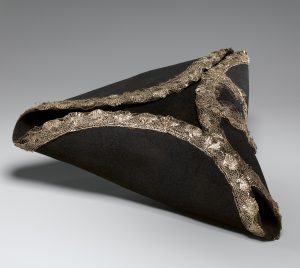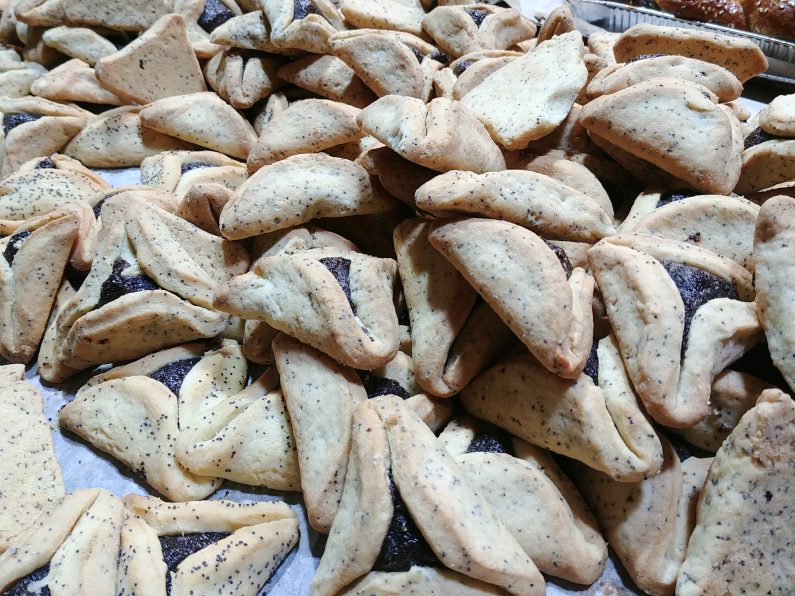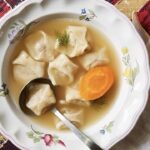Hamantaschen: those triangular stuffed cookies that so many of us eat on Purim. What do they actually have to do with this holiday? The answer is actually more complicated than you might think, but not as asinine as some might make it out to be (i.e. there actually is some mild significance).
The most common explanations you will hear are that they remind us of the villainous Haman‘s ears or his three-cornered hat. The only problem is, we have no source or reason to believe that the bad guy in the Purim story had oddly deformed ears. And the tricorne hat only became popular in the 17th century, thousands of years after the events recounted in the Book of Esther.
Haman’s Ears (and other body parts)

Sephardim everywhere eat treats on Purim named for Haman’s limbs. One of the oldest is a Spanish pastry called foulares, with a hard boiled egg baked into the center and strips of dough crisscrossing the top. Some shaped this like Haman’s foot.(1)See such sources as Eat and Be Satisfied by John Cooper and The Book of Jewish Food by Claudia Roden. (The connection between a hard boiled egg and Haman’s foot will probably never be explained.) In Morocco, this is doubled, with two such eggs, mimicking the eyes in Haman’s face, and the diners have the custom to rip it apart as if ripping out Haman’s eyes! The food there is called boyosa, boyoja or ojos de haman. In Greece, other Purim pastries included dontia tou Amman (Haman’s teeth) and even the one-step-removed psires tou Amman (Haman’s fleas)!(2)Cookbook of the Jews of Greece, Nicholas Stavroulakis
But by far the most common Sephardic Purim pastry is orecchi di Aman or orejas (or some other variation), which means… Haman’s ears.(3)The Jewish Kitchen by Clarissa Hyman, The Classic Cuisine of the Italian Jews, Vol I by Edda Servi Machlin, Recipes from the Jewish Kitchens of Curacao, Sisterhood of Mikve Israel-Emanuel These holiday sweets, however, in no way resemble Hamantaschen. They essentially are twisted, fried strips of dough, with sugar and sometimes brandy or another alcohol. Some have suggested a connection between this and a medieval Italian custom of actually cutting the ears off of a criminal prior to his execution. Clearly, however, this is the most likely source for the hamantaschen’s name in Hebrew, despite Haman’s presumably elliptical ears. Since there was a name like this for one Purim cookie, it would have been easy to just transfer it to a different one.
All of these edible Haman body parts, however, may have a scriptural source, albeit a whimsical one. In describing the Israelites’ time in the desert, the book of Exodus says, “And the Children of Israel ate the Manna,” which in Hebrew reads “ובני ישראל אכלו את המן.” That sentence, however, can also be read as a pun: “And the Children of Israel ate Haman.” Thus it is possibly the reason why Jews ate Haman’s body parts on Purim, but did not eat those of Pharaoh or Antiochus on the holidays of Passover and Chanukkah. There is a long tradition of “Purim Torah” on this holiday — silly, joke-filled satirical words of Torah that increase the levity associated with the day.
So Why Do We Eat Hamantaschen?

The origin of these specific cookies is non-Jewish and German. There, the original stuffing was poppy seeds, one of the popular fillings still today (which I despise). The cookies were called by the descriptive German name “mohn taschen,” which literally translates to “poppy pockets.”(4)Eat and Be Satisfied Recognizing the similar sound, Jews turned mohn taschen into hamantaschen, and a long-standing Purim tradition was born!
It seems, however, that there may have been another reason to adopt these German pastries for Purim feasting. A tradition developed to eat seeds of various kinds on the holiday, stemming (via the Talmud) from a belief that Esther subsisted on a vegetarian diet in the palace of Ahaseurus, thus avoiding eating non-kosher food. Thus finding a pastry that not only punned on Haman’s name, but also allowed for consuming seeds on the holiday, made the hamantaschen particularly apt for the day. And since I don’t like poppy filling, I could still keep this tradition, if I wanted to, by eating hamantaschen with the popular Israeli halva filling, as it is made of sesame seeds.
Though there seems no direct source to point to for the three-cornered hat explanation, it probably developed out of an association with such hats in the 18th century with people in power.(5)this explanation is mentioned both by Roden and in the popular mid-20th century American cookbook The Jewish Home Beautiful, published by the Women’s League for Conservative Judaism. In the same way that people in Europe painted Biblical scenes with European architecture and clothing, this was simply a way of making the image come alive for the time and place. There were, however, some “backsplanations” given to the triangular shape. Some said it reminded us of the three Patriarchs in whose merit the Jews were saved, and others connected it to the three main figures in the Purim story: Esther, Haman and Ahaseurus.
Finally, there may be some connection between the custom of eating hamantaschen and that of eating kreplach on Purim. These are also typically triangular, and contain stuffing. There are many explanations for this custom, but one is because the victory of the Jews over Haman on this holiday has always been portrayed as a “hidden” miracle. The meat-filled dumplings offer a hidden surprise… as do the hamantaschen!
I’d like to take this opportunity to wish you a joyous and happy Purim. I hope you all find ways to celebrate, safely and with good humor. And please don’t feel obligated to eat any fleas or cut off your enemies’ ears!
Footnotes
| ↑1 | See such sources as Eat and Be Satisfied by John Cooper and The Book of Jewish Food by Claudia Roden. |
|---|---|
| ↑2 | Cookbook of the Jews of Greece, Nicholas Stavroulakis |
| ↑3 | The Jewish Kitchen by Clarissa Hyman, The Classic Cuisine of the Italian Jews, Vol I by Edda Servi Machlin, Recipes from the Jewish Kitchens of Curacao, Sisterhood of Mikve Israel-Emanuel |
| ↑4 | Eat and Be Satisfied |
| ↑5 | this explanation is mentioned both by Roden and in the popular mid-20th century American cookbook The Jewish Home Beautiful, published by the Women’s League for Conservative Judaism. |






